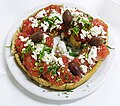Cretan cuisine
Cretan cuisine (Greek: Κρητική κουζίνα), also known as the Cretan diet is the traditional cuisine and diet of the Mediterranean island of Crete.
Background[edit]
The core of Cretan cuisine primarily emphasises a plant-based diet, where food derived from plants forms the bulk of consumption, while animal products are more peripheral. Historically, the local diet leveraged seasonal and locally available produce that underwent minimal processing. Until the 1960s, this traditional eating pattern was predominant across Crete but began evolving with higher living standards, leading to an increased intake of meat and other animal-derived products.
The diet in Crete traditionally consisted of fresh and dried fruits, legumes, endemic wild herbs, aromatic plants, and rough cereals like barley, all well-suited to the regional climate. Vegetables and legumes, in particular, made up about 70% of the traditional diet, reflecting their central role. Fish and seafood, constituting about 20% of the diet, were consumed weekly in moderate amounts, while meat, mainly poultry, making up only about 10%, was eaten just a few times a month.
Dairy products were consumed daily in low to moderate quantities. Olive oil, the primary source of fat, was a staple used in both salads and cooking, distinguishing the Cretan dietary practice from those of northern European countries, which often relied more on carbohydrates and animal fats. Alcohol consumption was moderate, typically involving red wine with meals.
The tradition of consuming legumes every Monday, a day when eating meat is traditionally avoided, particularly aligns with the contemporary meatless Monday campaign and the religious observance of Clean Monday in Greece marking the start of Lent.
For desserts, the diet favored yogurt and fresh fruits, with traditional pastries sweetened by honey enjoyed rarely. This pattern of eating emphasises minimal processing and underscores the sustainable, health-focused culinary traditions of the island.
Appetizers[edit]
- Dakos (salad)
- Stamnagathi (cichorium) salad
- Piktí (or Tsiladiá), pork charcuterie
- Apáki, smoked pork (or chicken) meat
- Paximadi
- Kalitsounia
- Kolokythoanthoi
- Kolokythopita
- Marathopita
- Mizithropita, mizithra sandwich
- Sykoti Savore, liver cooked in vinegar
- Staka, buttercream roux
- Graviera cheese
- Xynomizithra cheese
- Xygalo cheese
- Pichtogalo cheese
- Other cheeses include Amarino, Seliano, Tirozouli, Tiromalama
Specialities[edit]
- Antikristo (or Oftó), lamb meat
- Blessed thistle with lamb
- Hirino me selino, pork meat with celery
- Gamopilafo, rice cooked in goat and rooster broth
- Snails with tomato
Η ohlioi boubouristoi, snails fried with rosemary and vinegar- Sfougato (omelette with potatoes/pumpkin)
- Sofegada, vegetables
- Triftoudia, type of orzo
- Types of pasta, such as Skioufichta, Magiri, Chilofta, Avgochilos
- Xerotigana, dessert
- Amygdalopita (dessert)
- Patouda (dessert)
- Portokalopita (dessert)
Drinks[edit]
Gallery[edit]
-
Kolokythoanthoi are often served with a dollop of yoghurt on the side (zucchini flowers)
-
Snails with tomato
-
Rakomelo




